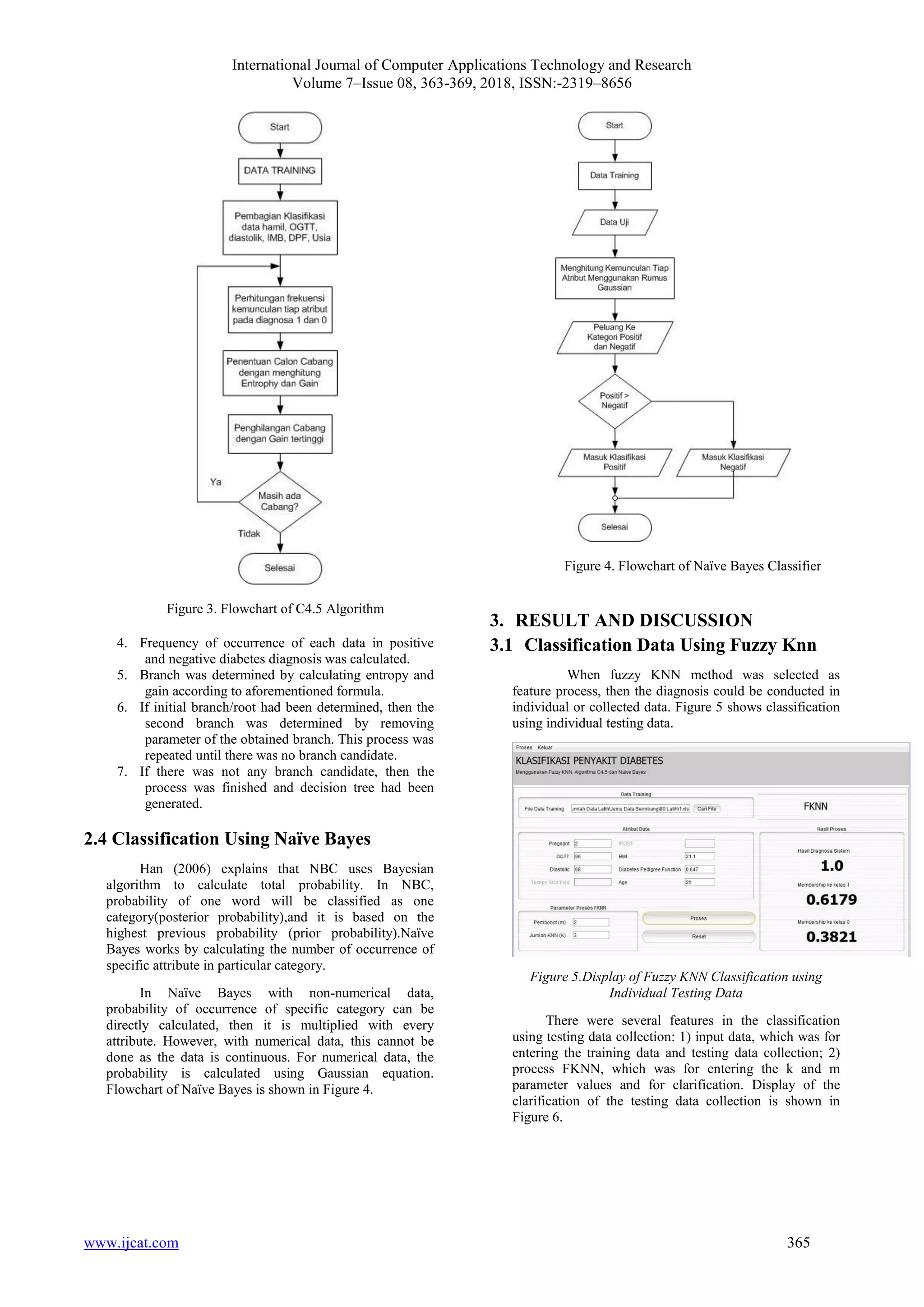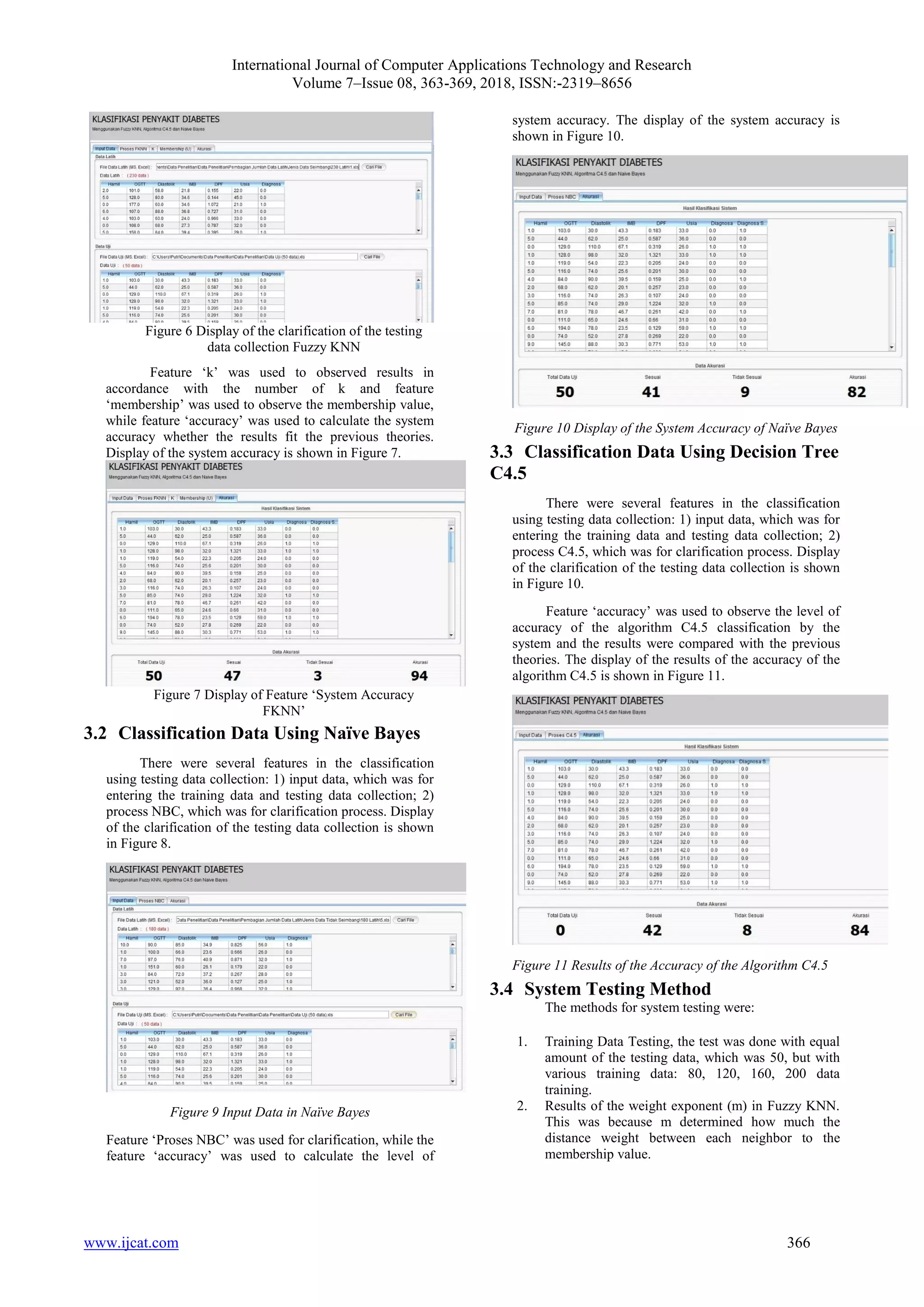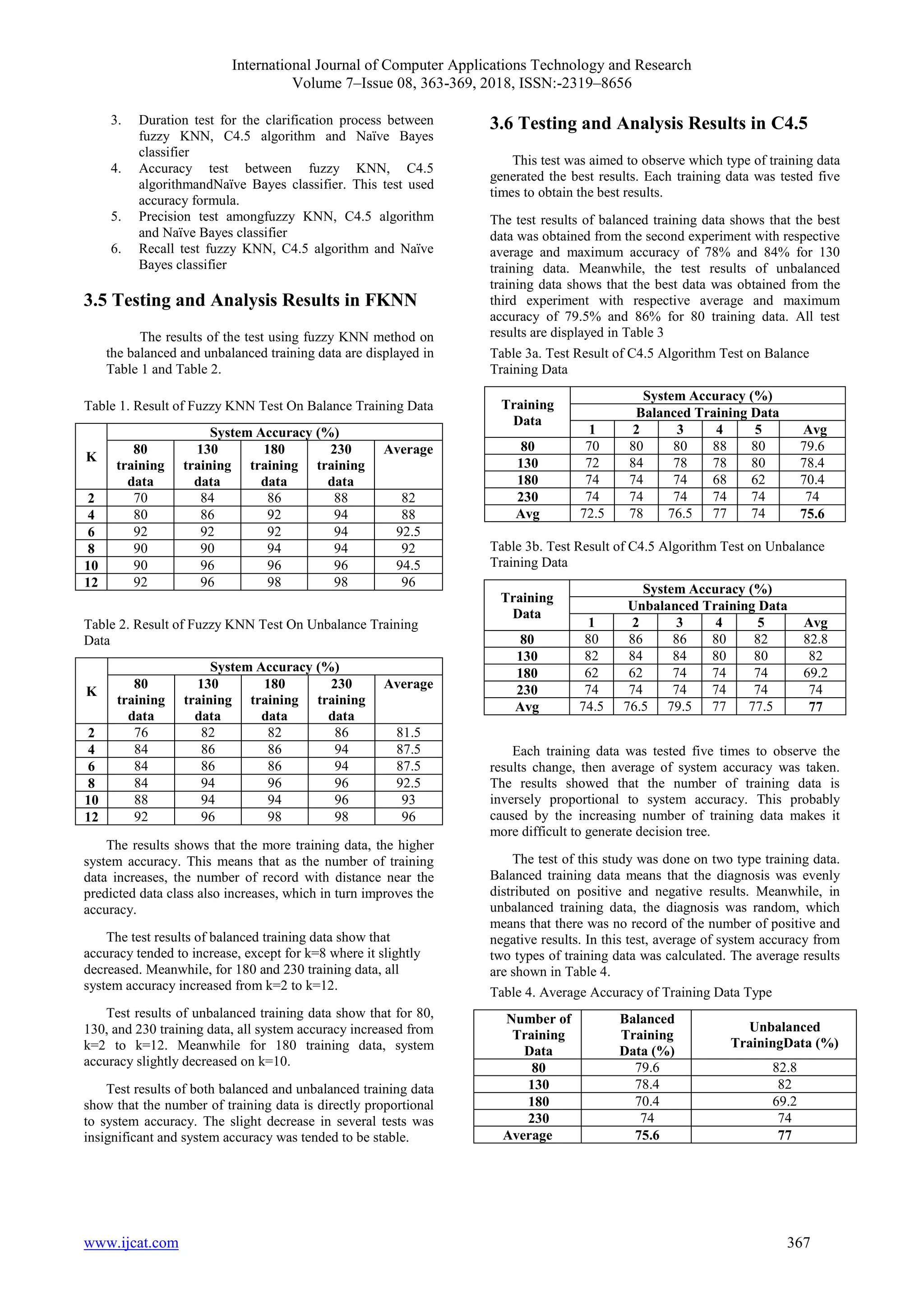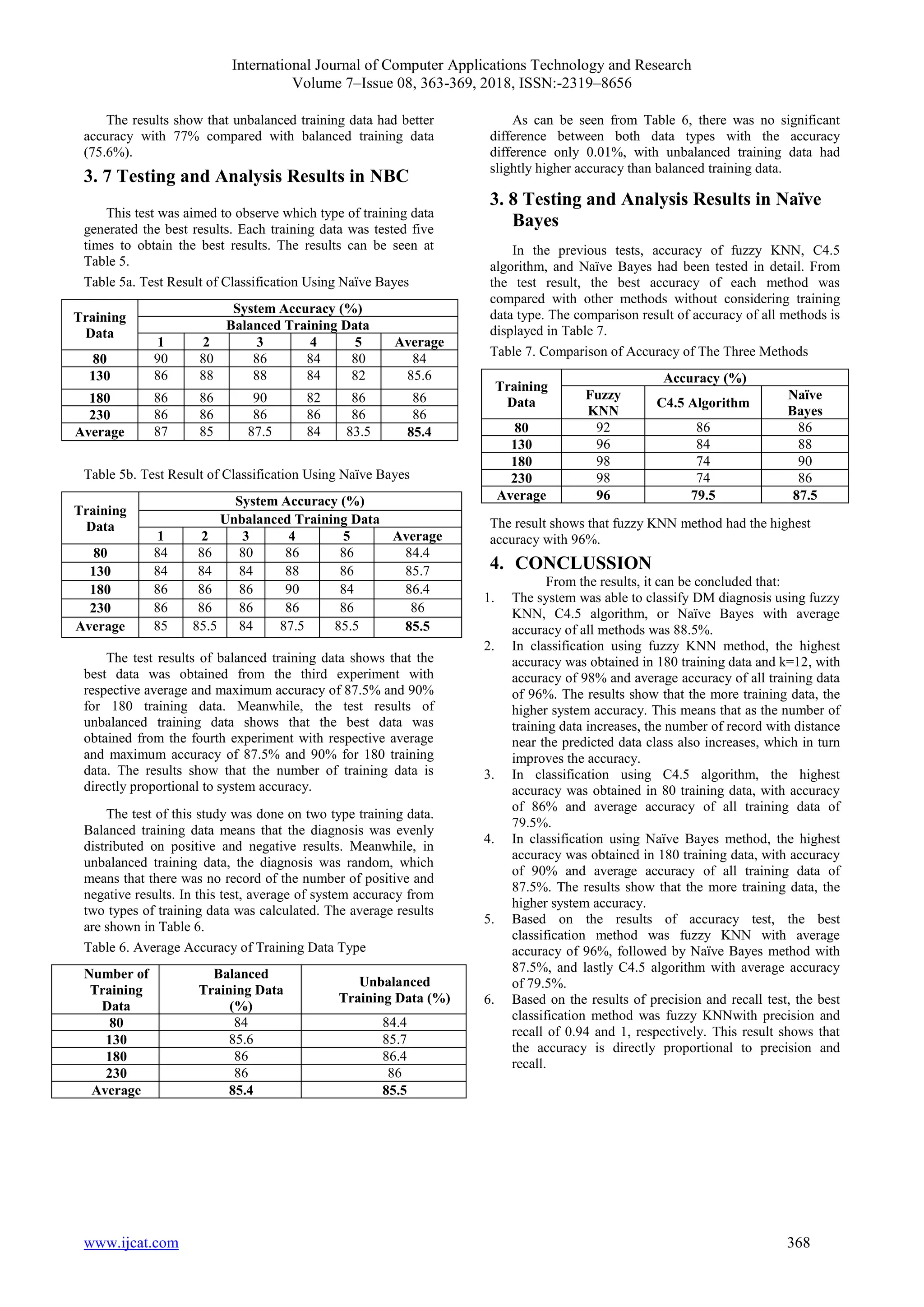The study compares three classification methods—fuzzy KNN, C4.5 algorithm, and Naïve Bayes classifier—for diagnosing diabetes mellitus using data from the UCI Pima database. Results indicate that fuzzy KNN is the most accurate with a maximum accuracy of 98%, followed by Naïve Bayes at 90%, and C4.5 at 86%. The research emphasizes the importance of early detection of diabetes to prevent complications.
![International Journal of Computer Applications Technology and Research
Volume 7–Issue 08, 363-369, 2018, ISSN:-2319–8656
www.ijcat.com 363
Analysis of Comparison of Fuzzy Knn, C4.5 Algorithm,
and Naïve Bayes Classification Method for Diabetes
Mellitus Diagnosis
Putri Elfa Mas`udia
Departement of Electrical
Engineering
State Polytechnic of Malang
Malang, Indonesia
Ridwan Rismanto
Departement of Technology
Information
State Polytechnic of Malang
Malang, Indonesia
Abdullah Mas`ud
Departement of Electrical
Engineering
State Polytechnic of Malang
Malang, Indonesia
Abstract: Early detection of diabetes mellitus (DM) can prevent or inhibit complication. There are several laboratory test that must be
done to detect DM. The result of this laboratory test then converted into data training. Data training used in this study generated from
UCI Pima Database with 6 attributes that were used to classify positive or negative diabetes. There are various classification methods
that are commonly used, and in this study three of them were compared, which were fuzzy KNN, C4.5 algorithm and Naïve Bayes
Classifier (NBC) with one identical case. The objective of this study was to create software to classify DM using tested methods and
compared the three methods based on accuracy, precision, and recall. The results showed that the best method was Fuzzy KNN with
average and maximum accuracy reached 96% and 98%, respectively. In second place, NBC method had respective average and
maximum accuracy of 87.5% and 90%. Lastly, C4.5 algorithm had average and maximum accuracy of 79.5% and 86%, respectively.
Keywords : Fuzzy KNN, C4.5 Algorithm, Naïve Bayes Classifier, Diabetes Mellitus
1. INTRODUCTION
Diabetes mellitus (DM) is a disease marked by high
level of blood sugar caused by impaired insulin secretion,
insulin disruption, or both.DM is a heterogeneous group
marked by increase on glucose level in the blood or
hyperglycemia [1].
There are various classification methods, such as K-
nearest neighbor (KNN), fuzzy KNN (F-KNN), decision
treemethod using C4.5 algorithm, Naïve Bayes classifier
(NBC) method, and many other methods. In previous studies,
one of this methods was used to classify a problem without
analyzing which classification method produce the best result.
Yanita Selly conducted a study in 2013 to compare KNN and
F-KNN methods. The result showed that F-KNN method is
better than KNN method, as accuracy of F-KNN reached 98%
while KNN only had 96% accuracy [12].
The result was then further analyzed in this study, where
F-KNN, decision tree method using C4.5 algorithm, and
Naïve Bayes classifier (NBC) method were compared. The
results of these three methods were analyzed to obtain the best
classification method.
A. Research Objective
1. To apply fuzzy KNN method, decision tree method using
C4.5 algorithm, and Naïve Bayes classifier (NBC)
methodin diagnosing DM.
2. To create a software to compare the three methods based
on accuracy, time, precision, and recall.
B. Related Results from Previous Studies
Yanita Selly dkk compared DM classification using
K-nearest neighbor (KNN) and fuzzyKNN methods.
KNN is a classification method that perform strict
prediction on tested data based on k nearest neighbor.
Meanwhile, F-KNN predicts tested data based on
membership value of tested data in each class, and then
class data with highest membership was selected as
resulting predicted class. The study results showed that
F-KNN method is better than KNN method, as accuracy
of F-KNN reached 98% while KNN only had 96%
accuracy [12].
Other study conducted by Parida Purnana regarding
detection of Type II DM using Naïve Bayesbased on
particle swarm optimization. In the study, particle swarm
optimizationwas used to improve accuracy in detecting
DM. The study result showed that this method had
98.16% accuracy and 0.99 AUC, thus it can be classified
as ‘excellent classification’ [9].
Larissa dkk conducted study regarding classification
of client using C4.5 algorithm as creditingbasis. This
study classify clients of a bank, so that when a problem
occurs, the bank could easily obtain rules from the
resulting decision tree. With decision tree method using
C4.5 algorithm, process of gathering information was
faster and more optimal with larger number of data,
therefore the error in decision making could be
minimized [4].
2. SYSTEM PLANNING
The steps of this research were:
1. Studying literatures regarding fuzzy KNN, C4.5
algorithm, and Naïve Bayes classifier methods.
2. Studying dataset from Indian Pima Diabetes that were
used as trainingdata
3. Designing software to perform classification in
accordance with tested methods.
4. Applying fuzzy KNN, C4.5 algorithm, and Naïve
Bayes classifier methodsto diagnose DM.](https://image.slidesharecdn.com/ijcatr07081011-220806085021-b46cbd36/75/Analysis-of-Comparison-of-Fuzzy-Knn-C4-5-Algorithm-and-Naive-Bayes-Classification-Method-for-Diabetes-Mellitus-Diagnosis-1-2048.jpg)
![International Journal of Computer Applications Technology and Research
Volume 7–Issue 08, 363-369, 2018, ISSN:-2319–8656
www.ijcat.com 364
5. Testing and analyzing the results of each method and
calculating the accuracy.
2.1 Data Preprocessing Method
This study used dataset that were then classified as
training data and testingdata. These data were obtained
from UCI machine learning repository database: Indian
Pima Diabetes in http://archieve.ics.uci.edu. There are
768 clinical data in Indian Pima database but not all
attributes are completely available.
768 clinical data obtained from Indian Pima
Database were preprocessed, which means that
insignificant data was deleted to maximize classification
result. Missing valueor data with incomplete attributes
was treated using rules from [LES-12], since the
classification result is highly influential to training data.
From 8 parameter of data, parameters of TSFT and
INS were deleted since the missing value was very large.
The preprocessed data are displayed in Figure 1.
Figure 1 Preprocessed Data
Used training data had six parameters, which were
hamil, ogtt, diastolik, IMB, DPF and Usia. These parameters
were used in classification process. The value of each
parameter was used to determine diabetes diagnosis, where
value of ‘1’ means positive diabetes and ‘0’ means negative
diabetes
2.2 System Description
This study compared three classification methods,
which were fuzzy KNN, C4.5 algorithm, and Naïve Bayes
classifier. Classified data were generated from Indian
Pimadatabase. This study designed a software for
classification process and the results were used to
determine the best method. Process of the study is
displayed in Figure 2.
Figure 2. Flowchart of the Study
2.3 Classification using Fuzzy KNN Method
In general, classification using fuzzy KNN method was
conducted following these steps:
1. Input normalized training data.
2. Determine k value as initial parameter.
3. Determine weight exponent (m), this study used m = 2.
4. Calculate distance between new record data and each
record training data using Euclidian distance.
5. Calculate membership value of each class, class with the
highest membership value then used to determine new
target.
6. Output was the result of the class with the highest
membership value.
2.4 Classification using Fuzzy KNN Method
In Anyanwu journal, Podgorelec explains that C4.5
algorithm is a development of ID3 algorithm that is used
in generating decision tree. C4.5 algorithmis not limited to
binary number and is able to generate decision tree with
multiple variables. Attributes in C4.5 algorithm generate
one branch for every attribute branch in default [7]. Steps
of classification process using decision tree C4.5 in
general can be expressed as flowchart that is displayed in
Figure 3.
Flowchart of decision tree C4.5 algorithm can be
explained as:
1. Training data was required for classification process
2. Since data hamil, Ogtt, Diastolik, IMB, DPF and
Usia were numerical data, early classification was
done to minimize branch for further selection
3. Training data was required for classification process](https://image.slidesharecdn.com/ijcatr07081011-220806085021-b46cbd36/75/Analysis-of-Comparison-of-Fuzzy-Knn-C4-5-Algorithm-and-Naive-Bayes-Classification-Method-for-Diabetes-Mellitus-Diagnosis-2-2048.jpg)




![International Journal of Computer Applications Technology and Research
Volume 7–Issue 08, 363-369, 2018, ISSN:-2319–8656
www.ijcat.com 369
5. REFERENCES
[1] Brunner and Suddarth. 2002. Buku Ajar Keperawatan
Medikal Bedah, edisi 8 volume 2. Jakarta : EGC.
[2] Keller, James. 1985. A Fuzzy K-Nearest Neighbor. IEEE
vol. SMC-15, No. 4
[3] Kusrini, 2007. Design and implementation of building
decision tree using C4.5 algorithm. Proceedings of
SEAMS-GMU Conference 2007.
[4] Larrisa Navia Rani, 2015. Klasifikasi Nasabah
Menggunakan Algoritma C4.5 Sebagai Dasar
Pemberian Kredit. Jurnal Kom Tek Info Fakultas Ilmu
Komputer Volume 2 No. 2. ISSN : 2356-0010
[5] Li D, Deogun JS, Wang K (2007) Gene Function
Classification Using Fuzzy K-Nearest Neighbor
Approach.
[6] Manning, D. Cristopher, Prabakhar Raghavan dan
Hinrich Schutze. 2009. An Introduction to Information
Retrieval. Cambridge University Press.
[7] Maimon, O. dan Last, M. 2000. Knowledge Discovery
and Data Mining, The Info-Fuzzy Network (IFN)
Methodology. Dordrecht: Kluwer Academic.
[8] Mistra. 2005. 3 Jurus Melawan Diabetes Mellitus.
Jakarta : Puspa Swara.
[9] Purnana, Parida. Dan Supriyatno, Catur.2013 Deteksi
Penyakit DiabetesType II denganNaive Bayes Berbasis
Particle Swarm Optimization. Jurnal Teknologi
Informasi Volume 9 No.2 ISSN 1414-9999.
[10] Sunjana, 2010, Aplikasi Mining Data Mahasiswa
dengan Metode Klasifikasi Decision Tree, Seminar
Nasional Aplikasi Teknologi Informasi, Vol 7 pp. 24-
29.
[11] Tandra, Hans. 2009. Osteoporosis Mengenal,
Mengatasi, dan Mencegah Tulang Keropos. Jakarta:
Gramedia Pustaka Utama.
[12] Yanita, Selly, ridho, ahmad. & lailil. 2013.
Perbandingan K-Nearest Neighbor dan Fuzzy K-
Nearest Neighbor pada Diagnosis Penyakit Diabetes
Melitus.Jurnal Doro Volume 2 no.10
[13] Han, J. and Kamber, M., 2006. Data Mining: Concepts
and Techniques, University of Illinois at Urbana-
Champaign](https://image.slidesharecdn.com/ijcatr07081011-220806085021-b46cbd36/75/Analysis-of-Comparison-of-Fuzzy-Knn-C4-5-Algorithm-and-Naive-Bayes-Classification-Method-for-Diabetes-Mellitus-Diagnosis-7-2048.jpg)